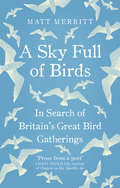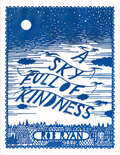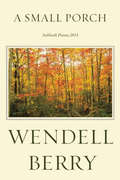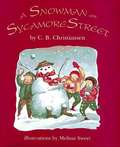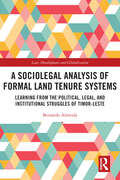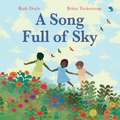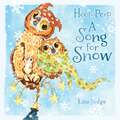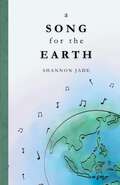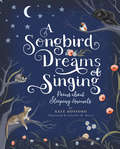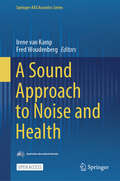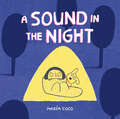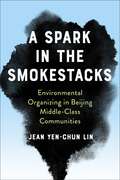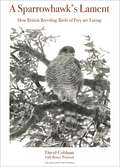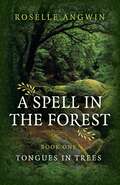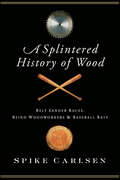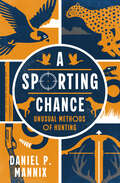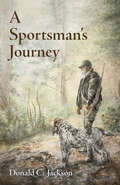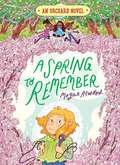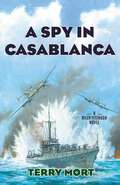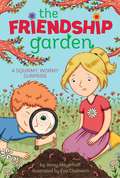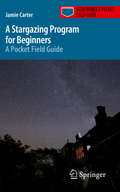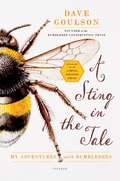- Table View
- List View
A Skunk in the House
by Constance Taber ColbyBringing a new baby home is a memorable occasion--especially when the baby disappears behind the washing machine and steadfastly refuses to come out. One furious little skunk, acquired from a pet shop, took up residence under the Colbys' washer and launched the family into a series of unexpected, often hilarious adventures which Constance Taber Colby relates in this delightful book. The story of Secret--a name the family decided on after long debate--is told with sensitivity and affection; the reader shares the Colbys' excitement as they follow the little creature's step-by-step acceptance of, and affection for, his family. Secret, however, had his own ideas about training--training them--and soon the Colby household, whether in its Manhattan apartment or at Stillmeadow Farm, was geared to his routine. With unwavering determination Secret turned his environment into a proper habitat for a skunk. He forged his own trails through the house and chose his own favorite places for napping. He followed a rigid daily schedule and even initiated games and play periods with the single-mindedness of a cruise director. A Skunk in the House, an intriguing portrait of an unconventional pet, also reveals a charming family sharing the joys--and the sorrows--of daily life. More than that, Constance Taber Colby has produced a clear-eyed account of what happens when man comes in close contact with nature--nature in the form of one stubborn, instinct-governed, and quite amiable but untamable animal. Life with a skunk, with its odd surprises and unexpected lessons, is a humbling experience, Mrs. Colby admits, as four humans learned to adjust to--and respect--the integrity of a wild creature. Constance, daughter of Gladys Taber, studied historical linguistics at the University of Michigan and Columbia, and archaeology at the National University of Mexico. She has taught at a number of universities and colleges and most recently at Barnard. Mrs. Colby, her husband, and two daughters divide their time between Stillmeadow Farm in Connecticut and an apartment in New York City.
A Sky Full of Birds
by Matt Merritt'Prose from a poet and a personal take on the spectacles' Chris Packham, author of Fingers in the Sparkle JarShortlisted for Richard Jefferies Society & White Horse Bookshop Literary Prize 2017Longlisted for the Wainwright Prize 2017Britain is a nation of bird-lovers. However, few of us fully appreciate the sheer scale, variety and drama of our avian life. From city-centre hunters to vast flocks straight out of the Arctic wilderness, much-loved dawn songsters to the exotic invaders of supermarket car parks, a host of remarkable wildlife spectacles are waiting to be discovered right outside our front doors.In A Sky Full of Birds, poet and nature writer Matt Merritt shares his passion for birdwatching by taking us to some of the great avian gatherings that occur around the British isles – from ravens in Anglesey and raptors on the Wirral, to Kent nightingales and Scottish capercaillies. By turns lyrical, informative and entertaining, he shows how natural miracles can be found all around us, if only we know where to look for them.A Sky Full of Birds is the perfect read for avid birdwatchers and a beautiful gift for lovers of nature and poetic prose.
A Sky Full of Kindness
by Rob RyanRob Ryan's papercut prose is so exquisitely intricate, it begs closer examination—and always captures a lingering eye. The story Ryan tells in this jacketed hardcover is a celebration of love and family just as heartfelt as it is visually arresting: two songbirds eagerly anticipate the arrival of their first child, and as they tend to their nest, they can't help but worry about becoming parents. It's the generosity and support of their avian friends and neighbors that confirms the world awaiting their unborn chick is indeed full of kindness. Brimming with poetic verse, each page is a work of art that will charm new parents and longtime fans of Ryan's evocative imagery.
A Small Porch: Sabbath Poems 2014 and 2015
by Wendell BerryMore than thirty-five years ago, when the weather allowed, Wendell Berry began spending his sabbaths outdoors, walking and wandering around familiar territory, seeking a deep intimacy only time could provide. These walks arranged themselves into poems and each year since he has completed a sequence dated by the year of its composition. Last year we collected the lot into a collection, This Day, the Sabbath Poems 1979-2013. This new sequence for the following year is one of the richest yet. This group provides a virtual syllabus for all of Mr. Berry's cultural and agricultural work in concentrated form. Many of these poems are drawn from the view from a small porch in the woods, a place of stillness and reflection, a vantage point "of the one/life of the forest composed/of uncountable lives in countless/years each life coherent itself within/ the coherence, the great composure,/of all." A new collection of Wendell Berry poems is always an occasion of joyful celebration and this one is especially so.
A Snowman On Sycamore Street
by C. B. ChristiansenThree children are having fun building a snow man in the snow. They also share Valentines and help one another. Good book for all ages. Delightful picture descriptions brings this story to life for blind readers. This file should make an excellent embossed braille copy.
A Sociolegal Analysis of Formal Land Tenure Systems: Learning from the Political, Legal and Institutional Struggles of Timor-Leste (Law, Development and Globalization)
by Bernardo Ribeiro AlmeidaThis sociolegal study focuses on the political, legal and institutional problems and dilemmas of regulating land tenure. By studying the development of the Timorese formal land tenure system, this book engages in the larger debate about the role of state systems in addressing and aggravating social problems such as insecurity, poverty, inequality, destruction of nature, and cultural and social estrangement. Land tenure issues in Timor-Leste are complex and deeply shaped by the nation’s history. Taking an insider’s perspective based on the author’s experience in Timorese state administration, and through the investigation of five analytical themes –political environment, lawmaking, legal framework, institutional framework, and social relationships and practices– this book studies the development of the Timorese formal land tenure system from independence in 2002 to 2018. It shows how political, legal, and administrative decisions on land administration are made, what and who influences them, which problems and dilemmas emerge, and how the formal system works in practice. The result is a portrait of a young nation grappling with the enormous task of creating a land tenure system that can address the needs of its citizens in the wake of centuries of socio-political tumult and huge fluctuations in resources. The book concludes by highlighting the importance of lawmaking and how abuses of power can be curbed by adequate administrative processes and laws. Finally, it argues that land administration is primarily a political matter. The political dimension of technical solutions must be considered if we aim to achieve fairer formal land tenure systems. The pertinence of the topics covered, the multi-disciplinary perspective, and the research methodology followed make this book appealing to a variety of readers, including international organizations, practitioners, academics and students engaged in land administration, post-colonial and -conflict issues, lawmaking, rule of law, public administration and issues of access and exclusion.
A Song Full of Sky
by Ruth DoyleA joyful picture book celebrating the beauty and wonder of nature, and its power to improve well-being whilst soothing anxieties among little onesFrom galloping horses to moon-dappled owls, sun-scented flowers and soft floating bees, this joyful picture book celebrates the beauty and wonder of nature - and encourages every child to claim their rightful place within it!A powerful manifesto for reconnecting with nature, wherever we find it.
A Song for Snow (Hoot and Peep)
by Lita JudgeA young owl experiences the magic of a first snowfall—the quiet wintery wonder, the pristine beauty, and snowballs!—in this follow-up to the adorable Hoot and PeepIt&’s Peep&’s first winter, and it&’s going to snow very, very soon. Peep has so many questions for her older brother Hoot: Does snow drop, polppety splop, like the rain's song? Does it scrinkle scrattle like falling leaves? But Hoot can't remember snow very well. The one thing he knows for sure is that it is worth waiting for.But Peep doesn't have his patience, and as she flies around the gorgeous Paris skies, she tries her best to make up her own snow song. But once those first snowflakes start to fall, Peep realizes just how wise her older brother really is for waiting...and just who she wants to cuddle up to when the snow starts to really sing.With all the wonder and the joy of a first snow day, and perfect for fans of The Quiet Book and Little Owl's Night, this tender follow-up to Hoot and Peep is certainly worth waiting for, too.
A Song for the Earth
by Shannon JadeA Song for the Earth is a lyrical novel in verse written by an environmental scientist and designed to offer a hopeful perspective on the climate crisis. <P><P> <li> #1 BESTSELLER IN NATURE POETRY (INGRAMSPARK) <li> WINNER, REGAL SUMMIT BOOK AWARD (POETRY) 2025 <li> BOOK OF THE YEAR FINALIST, ABLE GOLDEN BOOK AWARDS 2025 <li> NOMINEE, VICTORIAN PREMIER'S LITERARY AWARDS 2026 <li> NOMINEE, FIVE ISLANDS POETRY PRIZE 2025 <P><P> The wide, wild world is made of wonder, but as climate change reinvents the landscape, rich ecosystems are under threat. On a journey through Earth's major biomes, January learns the plight of the planet. Armed with the power of a voice made for poetry, she turns her lyrics into a call for action. Is it enough to write a song for the earth and ask the world to sing along?
A Song of Sun and Sky
by Jason CockcroftA seemingly endless road trip for Lula and her father only seems to get worse when the car breaks down in the middle of the desert. Things are too boring and too orange until Lula encounters a mysterious painter who shows her that the desert is full of so much more to explore. This is an exploration of color, lighting, and the magic of art and nature, filtered through the lens of a fictional interaction with the artist Georgia O'Keeffe. Learn about the colors you bring along everywhere you go.
A Songbird Dreams of Singing: Poems about Sleeping Animals
by Kate HosfordLearn more about the variety of fascinating ways animals sleep: from upside down and holding hands, to sleeping while swimming or flying!Did you know otters sleep while holding hands; zebra finches rehearse their songs while dreaming; ducks and dolphins sleep with one half of their brains at a time; and, frigate birds sleep while flying? A Songbird Dreams of Singing: Poems about Sleeping Animals is a book of poetry with a scientific-and child-friendly-underpinning. With a poem for every animal, followed by a paragraph explaining the fascinating science behind how that animal sleeps, this artfully compiled book captures the wonder of our ecosystem. Designed with the look of a classic storybook/collection, with special effects on the cover, the book makes the perfect gift for young children!
A Sound Approach to Noise and Health (Springer-AAS Acoustics Series)
by Irene Van Kamp Fred WoudenbergThis open access book highlights the negative and positive health effects of chronic exposure to environmental sound. It describes the state of the art in the field from a public health point of view and puts it in a broad societal perspective looking at sound from physical, social, psychological, economic and governance angles. Rather than a mere collection of papers around the theme as usually provided in special issues, this book offers a comprehensive look at the meaning of sound in society and its impacts and provides directions to further advance the field.
A Sound in the Night
by María CocoA girl and her dog go on a camping adventure in this wordless tale of resilience and its sweet rewards.In this wordless story, a girl and her dog enjoy a camping adventure: flying their kite, swimming in the lake, and making s'mores by the fire. But when night falls, they hear a sudden and loud CRACK break through the dark silence. As the eerie sounds continue and a shadow starts to grow outside their tent, they decide to take a look… What could it be? There's only one way to find out in this visual, heartwarming story from artist María Coco that's enriched with incredible suspense and charm that transcends words.
A Spark in the Smokestacks: Environmental Organizing in Beijing Middle-Class Communities
by Jean Yen-chun LinEnvironmental organizing in Beijing emerged in an unlikely place in the 2000s: new gated residential communities. After rapid population growth and housing construction led to a ballooning trash problem and overflowing landfills, many first-time homeowners found their new neighborhoods facing an unappetizing prospect—waste incinerator projects slated for their backyards.Delving into the online and offline conversations of communities affected by the proposed incinerators, A Spark in the Smokestacks demonstrates how a rising middle class acquires the capacity for organizing in an authoritarian context. Jean Yen-chun Lin examines how urban residents create civic life through everyday associational activities—learning to defend property rights, fostering participation, and mobilizing to address housing-related grievances. She shows that homeowners cultivated petitioning skills, informational networks, and community leadership, which they would later deploy against incinerator projects. To interact with government agencies, they developed citizen science–based tactics, a middle-class alternative to disruptive protests. Homeowners drew on their professional connections, expertise, and fundraising capabilities to produce reports that boosted their legitimacy in city-level dialogue. Although only one of the three incinerator projects Lin follows was ultimately canceled, some communities established durable organizations that went on to tackle other environmental problems.Drawing on interviews, participant observation, and ethnography, A Spark in the Smokestacks casts urban Chinese communities as “schools of democracy,” in which residents learn civic skills and build capacity for collective organizing. Through compelling case studies of local activism, this book sheds new light on the formation of civil society and social movements more broadly.
A Sparrowhawk's Lament: How British Breeding Birds of Prey Are Faring (WILDGuides #71)
by David CobhamBritain is home to fifteen species of breeding birds of prey, from the hedgerow-hopping Sparrowhawk to the breathtaking White-tailed Eagle. In this handsomely illustrated book, acclaimed British filmmaker and naturalist David Cobham offers unique and deeply personal insights into Britain's birds of prey and how they are faring today. He delves into the history of these magnificent birds and talks in depth with the scientists and conservationists who are striving to safeguard them. In doing so, he profiles the writers, poets and filmmakers who have done so much to change the public's perception of birds of prey. There are success stories—five birds of prey that were extinct have become reestablished with viable populations—but persecution is still rife. Featuring drawings by famed wildlife artist Bruce Pearson, this book reveals why we must cherish and celebrate our birds of prey, and why we neglect them at our peril.
A Spell in the Forest: Book 1 - Tongues in Trees
by Roselle Angwin'This book gently leads the reader into a new and deeper understanding of the forest and our ancient and intrinsic connection with the trees, that has been largely forgotten in this modern age. If you wish to develop and nurture a true affinity and knowledge of trees, then Tongues in Trees will most definitely help you to do that.' Luke Eastwood, author of The Druid Garden and The Druid's PrimerTrees occupy a place of enormous significance, not only in our planet&’s web of life but also in our psyche. A Spell in the Forest - Tongues in Trees is part love-song, part poetic guidebook, and part exploration of thirteen native sacred British tree species. Tongues in Trees is a multi-layered contribution to the current awareness of the importance and significance of trees and the resurgence of interest in their place on our planet and in our hearts.FROM THE BOOK:'Trees have always figured in human consciousness. I believe that when we walk among trees, or notice a particular tree, a kind of exchange happens. Trees love to be met.''Trees somehow mediate between ourselves and a different reality, a different order of consciousness – pre-verbal, post-verbal, trans-verbal, non-verbal – such a relief, sometimes.''Trees in a natural forest mirror and speak to something of the wild soul in a human. As we visit, we encounter and are supported by the elemental powers that reside in such places, and can more readily connect with our own instinctual natures and the wild soul.''Wildness is not to be confused with a state of chaos, being out of control, savage. It&’s a question of relinquishing the ego&’s grip to larger natural rhythms, cycles, surroundings: an essential aspect of thriving. When one does this, one is more receptive to one&’s environment, physical or more numinous.''Woodland, forest, strikes me as a perfect example of the individual and the community being gracefully, harmoniously and inextricably part of each other.' 'I walk the forest, listen for birds, rivers, cascades, stories of the wildwood rustling in the leaves... try and stay aware of the great mycorrhizal web beneath my feet connecting us all...''[T]he ancients knew that spending time among trees is one of the best approaches to health and healing. Recently, Japan has spent millions researching the health benefits of shinrin-yoku, forest-bathing.''In the forest I step into a different kind of time. It's not simply that it so clearly stretches back so far into the past, but also that it allows me what Thoreau described as a &‘broad margin&’ to my day.''&‘Mother trees&’, we know from work by Suzanne Simard, will reduce their own root competition to make room for their own offspring. Trees will also help neighbours of their own species if necessary.''Forests are liminal places, thresholds into a meeting of the physical and metaphysical, where we&’re on the cusp of another reality...''In our past, our physical survival and some of our sense of meaning came from an awareness and direct experience of our connectedness with the more-than-human. We need that awareness more than ever now.''Our being here, our walking on this earth, is a co-creation, a mutual belonging. How to live, if not in reciprocal affinity?'
A Splintered History of Wood: Belt-Sander Races, Blind Woodworkers & Baseball Bats
by Spike CarlsenIn a world without wood, we might not be here at all. Without wood, we wouldn't have had the fire, heat, and shelter that allowed us to expand into the colder regions of the planet. If civilization somehow did develop, our daily lives still would be vastly different: there would be no violins, baseball bats, chopsticks, or wine corks. The book you are now holding wouldn't exist. At the same time, many of us are removed from the world where wood is shaped and celebrated every day. That world is inhabited by a unique assortment of eccentric craftsmen and passionate enthusiasts who have created some of the world's most beloved musical instruments, feared weapons, dazzling architecture, sacred relics, and bizarre forms of transportation. In A Splintered History of Wood, Spike Carlsen has uncovered the most outlandish characters and examples, from world-champion chainsaw carvers to blind woodworkers, the Miraculous Staircase to the Lindbergh kidnapping case, and many more, in a passionate and personal exploration of nature's greatest gift.
A Sporting Chance: Unusual Methods of Hunting
by Daniel P. MannixThe award-winning author of The Way of the Gladiator shares his experiences hunting with strange devices—and animals—in this classic book. Falcons, boomerangs, spears. . . In the mid-twentieth century, hunters of all shapes and sizes were in favor of giving their quarry a fighting chance. A revival of ancient sporting techniques was taking the hunting world by storm. The old ways required more skill and were, therefore, a greater challenge. They also brought people closer to nature. Among those embracing this philosophy was author Daniel P. Mannix, who was more interested in learning an antique skill than shooting a new gun. In these pages, he delves into the history of hunting and gives readers firsthand accounts of his attempts at bagging pigeons with a feral cat (an ocelot named Tiba), using a blowgun with poisoned darts for deer in Mexico, teaching an otter to retrieve downed ducks, tracking—and trapping—humans, and other odd, old-school techniques.&“A gripping compendium of hunting devices and trained animals that give the prey a sporting chance, this is easily the best hunting book in years.&” —Kirkus Reviews
A Sportsman's Journey
by Donald C. JacksonA Sportsman's Journey lyrically and spiritually connects readers with the natural world. Donald C. Jackson explores the rhythms and ways of hunting and fishing, particularly in America’s Deep South, and in so doing helps readers understand and find meaning in why hunters and anglers venture far afield. Journeying alongside the author, readers will savor the magic of sunrises and the mystery of twilight. Hearts will quicken as deer drift from shadows and ducks circle a woodland pond. The ocean will challenge them as they fight large fish from the deck of a wave-tossed boat far out at sea. Restless winds will whisper messages during a spring squirrel hunt on a Mississippi farm. Bird dogs, old guns, old friends, and times shared with loved ones will remind anglers and hunters of those special, shared memories. Ancient forests and powerful rivers remind us of our fragile, ephemeral state. Quail hunts strengthen cherished relationships with companions. Encounters with a mountain man will take us into a world thought to have vanished generations ago. A gathering of anglers on a Gulf Coast fishing pier at night reminds us of those hidden communities that exist around us, and are often unrecognized or perhaps even unknown. Jackson reveals how all of us depend on the natural world and share very personal interactions with it and with each other. This book reminds us that rediscovering, resurrecting, and celebrating these primal linkages are the real reasons we explore the world.
A Spring to Remember (An Orchard Novel #4)
by Natalie Andrewson Megan AtwoodSpring has sprung and the orchard crew tries their hand at matchmaking in this final novel of a sweet series about the bonds of friendship.The orchard is putting on a Valentine’s Day dance! And the town is once again totally involved. Lizzie and her friends have been tasked with decorations. When all four of them go into town to buy them, they see Sheriff Hadley and Sarah’s mom kissing beside a building! Sarah is shocked. But she’s the only one. Lizzie tries to comfort her but then to her surprise, Sarah is thrilled! She’s so thrilled in fact, she wants to hurry them along. She wants a proposal. And she wants the gang’s help to get it. Lizzie is unsure—she thinks people should be able to do what they want. But Sarah is her best friend, so… Meanwhile, Lizzie has been taking singing lessons. She hates them—she’s really not that good. But her parents decided she needed to “find her voice” and thought this was a great way to do it. Lizzie doesn’t want to hurt their feelings so she doesn’t say anything. Sarah gets the gang to scheme ways to hint to Sheriff Hadley and her mom that they all know they’re together and they want them to get married. Now Lizzie’s really uncomfortable. Why doesn’t Sarah just talk to her mom? To make matters worse, her friends come up with an idea of a romantic moment at the Valentine’s Day Dance that involves a proposal and…a singing Lizzie. Can Lizzie find the courage to put a stop to all this? Or is she going to face her worst nightmare?
A Spy in Casablanca: A Riley Fitzhugh Novel (The Riley Fitzhugh Novels)
by Terry MortRiley Fitzhugh, former Hollywood private detective turned US Navy lieutenant, is recruited by the OSS for temporary duty as a naval spy in Morocco during the planning for Operation Torch, the Allied invasion of North Africa. Riley&’s assignment is to kidnap a French river pilot and extract him from Casablanca.Along the way, Riley meets an old flame from his days in Hollywood. She&’s an English aristocrat who may or may not be a German agent or an Allied double. Together with an employee of the US Consulate in Morocco—a lapsed Russian rabbi—they spirit the pilot out of French Morocco to Tangier. But some surprises are waiting for all of them in the end.
A Squeak, A Squeal and a Screech (Phonics Reader #31)
by Judith Bauer StamperA Dad tells his kids a spooky story, as they sit by the campfire
A Squirmy, Wormy Surprise
by Éva Chatelain Jenny MeyerhoffAnna starts a new school year with a new teacher who is very different in this sixth book in the Friendship Garden series.It’s a new school year, which means new books, new sharpened pencils, and a new beginning! Anna’s excited to start fourth grade, but she’s not excited about her fourth-grade teacher, Miss Lopez. Miss Lopez is nothing like Mr. Hoffman, Anna’s third grade teacher. For starters, Miss Lopez is S-T-R-I-C-T. She doesn’t allow talking or humming or anything fun. Not only that, but she seems to dislike Anna right off the bat. When Miss Lopez doesn’t pick Anna to help out in the class’s new butterfly garden, Anna realizes she needs to make Miss Lopez like her, once and for all. And she’s willing to do whatever it takes! But how do you force someone like you…especially a teacher?
A Stargazing Program for Beginners: A Pocket Field Guide (Astronomer's Pocket Field Guide)
by Jamie CarterSets out a simple month-by-month program to reveal all of the night sky's biggest and most beautiful secrets in just one year - and with only a few hours of stargazing each month By investing just an hour a week and $50 in binoculars, it's possible to learn a few simple techniques and quickly gain a real insight into the night sky's ever-changing patterns - and what they tell us about Earth, the seasons and ourselves. Searching more for a learned appreciation of nature and our exact place within the cosmos than academic scientific knowledge, science and travel writer Jamie Carter takes the reader on a 12 month tour of the night sky's incredible annual rhythms that say so much about Earth. During the journey he learns about the celestial mechanics at work in the skies above that are - to the beginner - almost beyond belief. As well as the vital constellations and clusters, and the weird and wonderful nebulas, he searches out "dark sky destinations" across the globe that help increase knowledge and give a new perspective on familiar night sky sights. On the journey he witnesses a solar eclipse and grapples with star-charts, binoculars, smartphone apps, telescopes, spots satellites and attempts basic astro-photography. By year's end, the reader will be able to glance at the night sky from anywhere on the planet and tell what direction he or she is facing, what time it is, where all the planets are and even where the Galactic Center Point is.
A Sting In The Tale: My Adventures With Bumblebees
by Dave GoulsonDave Goulson became obsessed with wildlife as a small boy growing up in rural Shropshire, starting with an increasingly exotic menagerie of pets. When his interest turned to the anatomical, there were even some ill-fated experiments with taxidermy. But bees are where Goulson's true passion lies—the humble bumblebee in particular. <p><p> Once commonly found in the marshes of Kent, the English short-haired bumblebee went extinct in the United Kingdom, but by a twist of fate still exists in the wilds of New Zealand, the descendants of a few pairs shipped over in the nineteenth century. Dave Goulson's passionate quest to reintroduce it to its native land is one of the highlights of a book that includes original research into the habits of these mysterious creatures, history's relationship with the bumblebee, and advice on how to protect the bumblebee for future generations. <p> One of the United Kingdom's most respected conservationists and the founder of the Bumblebee Conservation Trust, Goulson combines lighthearted tales of a child's growing passion for nature with a deep insight into the crucial importance of the bumblebee. He details the minutiae of life in the nest, sharing fascinating research into the effects intensive farming has had on our bee population and the potential dangers if we are to continue down this path.

